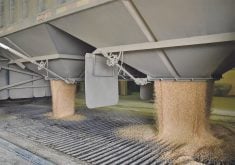“How are your crops?” asked the retired schoolteacher, a smart, engaging man.
“Really poor for the third year in a row,” I said, noting the area short of moisture was expanding and it wasn’t going to be a great crop for a lot of producers.
“So, have farmers now started to believe in climate change?” he asked.
I suspect most school teachers have a somewhat different view of climate change than most farmers. In general, the two camps would also be on opposite sides of the political spectrum.
Read Also

Kochia has become a significant problem for Prairie farmers
As you travel through southern Saskatchewan and Alberta, particularly in areas challenged by dry growing conditions, the magnitude of the kochia problem is easy to see.
He’s a really nice guy and he genuinely wanted to understand how producers trying to cope with drought could not also be save-the-climate crusaders. I drew a deep breath before responding.
“Well,” I said, “those of us who are a bit long in the tooth have seen dry years and wet years, hot years and years with early frost. Kind of tough to know what’s climate change and what’s natural variability.”
I didn’t delve into it at the time, but geological evidence such as tree-ring data show it was not uncommon in the distant past to have many drought years in succession. The brown and, to some extent the dark brown soil zones of Saskatchewan and Alberta, are characterized by low precipitation relative to the amount of evaporation that occurs.
A point I made with the school teacher was the irrelevance of whether farmers believe the doomsday climate change models.
“It isn’t like a particular farmer or even Canadian farmers in unison can do much to influence the climate.”
As I talked, he nodded.
“Considering Canada accounts for only 1.6 percent of global greenhouse gas emissions and most of that comes from sources other than agriculture, what we believe and what we do will not change the climate.”
Agriculture has a good story to tell regarding natural grasslands, minimum tillage and carbon sequestration. More can be done and will be done, but for farmers the top priority is to be as resilient as possible to whatever weather comes our way and whatever the long-term climate trends end up being.
Viewed from the outside, it may be difficult for observers to understand why farmers aren’t in the same camp as school teachers and the general population on the climate issue. Perhaps it’s because for city dwellers, the weather each day is only of passing interest. For farmers, the weather is almost always of critical importance.
And being practical people, most farmers can’t understand how the carbon tax is saving the planet. It’s certainly fueling inflation and making Canadian products less competitive on the world market. It’s making work for bureaucrats while Canadian carbon dioxide emissions have continued to increase.
Each year, as the carbon tax is raised, the federal government is doubling down on a failed policy. Meanwhile, the Bank of Canada raises interest rates to curb inflation, even though the carbon tax is a big reason everything is getting more expensive.
In the last election, the Conservative party made a critical error in proposing a different approach to carbon taxation rather than sticking to its guns and saying the tax needs to be repealed. The Conservatives under Pierre Poilievre seem unlikely to repeat that mistake.
Repealing the carbon tax is something a lot of Canadians might support as long as it comes with an overall plan for reducing emissions, perhaps even school teachers.
Kevin Hursh is an agricultural journalist, consultant and farmer. He can be reached by e-mail at kevin@hursh.ca.


















